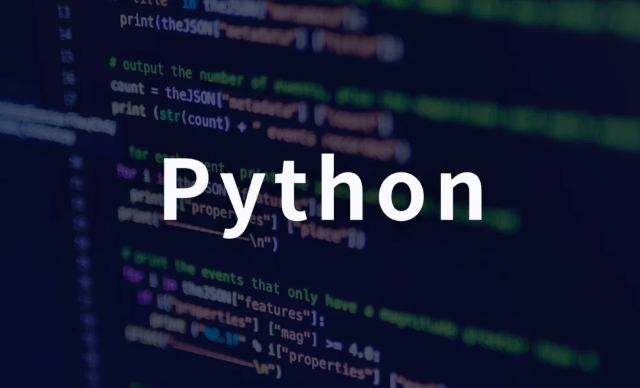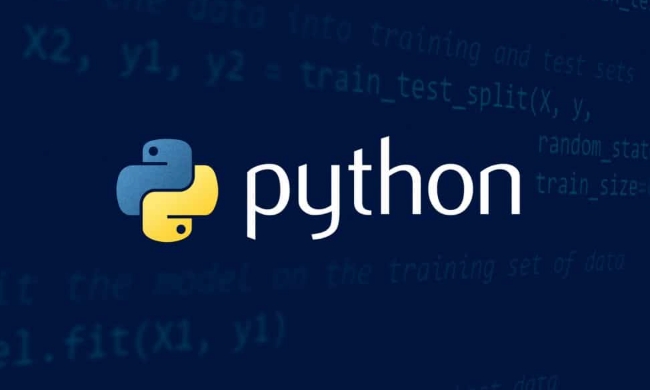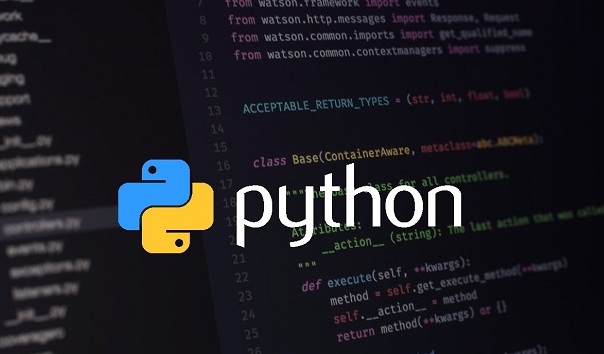 Backend Development
Backend Development
 Python Tutorial
Python Tutorial
 Working with Data Structures: Lists, Tuples, Dictionaries, Sets in Python
Working with Data Structures: Lists, Tuples, Dictionaries, Sets in Python
Working with Data Structures: Lists, Tuples, Dictionaries, Sets in Python
Jul 07, 2025 am 12:15 AMThe most commonly used data structures in Python are lists, tuples, dictionaries, and collections. 1. The list is mutable and orderly, suitable for storing content that needs to be frequently modified, and supports operations such as adding, inserting and deleting elements; 2. Tuples are immutable, suitable for data sets that will not change, have better performance and can be used as keys for dictionaries; 3. The dictionary stores data in key-value pairs, has high search efficiency, and is suitable for fast retrieval scenarios; 4. The set is used for deduplication and set operations, and has efficient member detection capabilities. Mastering their characteristics and applicable scenarios can improve code efficiency and clarity.

In Python programming, mastering basic data structures is the first step in writing good code. List, Tuple, Dictionary and Set are the four most commonly used data structures. They each have their own characteristics and are suitable for different scenarios.

List: Flexible Ordered Collection
Lists are one of the most commonly used and flexible data structures in Python. It is a variable, ordered collection of elements suitable for storing content that needs to be modified frequently.

- Lists are a great choice if you need to add or delete elements dynamically.
- For example, when recording the history entered by the user, you can use
append()to continuously add new content. - Common operations include:
-
list.append(x)add element to the end -
list.insert(i, x)inserts elements at the specified position -
list.pop(i)deletes and returns the element at the specified location
-
However, it should be noted that the efficiency of inserting or deleting lists in the middle is low. If the data volume is large and the intermediate position is frequently operated, other structures may be considered.
Tuple: Lightweight immutable container
Tuples are very similar to lists, but they are immutable and cannot be modified once created. This feature makes it "lighter" than lists and is more suitable for data collections that do not change.

- For example, when a function returns multiple values, the default return is a tuple.
- Because it is immutable, tuples can be used as keys to dictionaries (as long as the elements inside are hashable), while lists cannot.
- The creation method is simple, for example:
t = (1, 2, 3)ort = 1, 2, 3
If you have a dataset that does not need to be modified, using tuples will be safer and can improve performance.
Dictionary: Efficient key-value pair structure
Dictionary is one of the most powerful data structures in Python. It stores data in the form of key-value pairs , and is very efficient in finding it.
- For example, if you want to quickly find user information based on your username, it is very suitable to use a dictionary.
- Common operations:
-
d[key] = valueAdd or update key value -
d.get(key)gets the value to avoid errors when the key does not exist -
d.items()traverses all key-value pairs
-
It should be noted that the keys of the dictionary must be of immutable type (such as strings, numbers, tuples), and the value can be of any type.
Collection: Deduplication and relational operations
A set is an unordered and non-repetitive set of elements, suitable for deduplication, intersecting and difference set operations.
- For example, if you have a user access log, you can do it by simply converting it into a collection.
- Common operations:
-
set.add(x)Add element -
set.remove(x)deletes the element (if it does not exist, an error will be reported) -
a | bunion,a & bintersection,a - bdifference set
-
The collection is implemented using a hash table internally, so it is very fast to determine whether an element is included.
Basically that's it. These four data structures are often used in actual development. Understanding their characteristics and applicable scenarios can allow you to write clearer and more efficient Python code.
The above is the detailed content of Working with Data Structures: Lists, Tuples, Dictionaries, Sets in Python. For more information, please follow other related articles on the PHP Chinese website!

Hot AI Tools

Undress AI Tool
Undress images for free

Undresser.AI Undress
AI-powered app for creating realistic nude photos

AI Clothes Remover
Online AI tool for removing clothes from photos.

Clothoff.io
AI clothes remover

Video Face Swap
Swap faces in any video effortlessly with our completely free AI face swap tool!

Hot Article

Hot Tools

Notepad++7.3.1
Easy-to-use and free code editor

SublimeText3 Chinese version
Chinese version, very easy to use

Zend Studio 13.0.1
Powerful PHP integrated development environment

Dreamweaver CS6
Visual web development tools

SublimeText3 Mac version
God-level code editing software (SublimeText3)
 Polymorphism in python classes
Jul 05, 2025 am 02:58 AM
Polymorphism in python classes
Jul 05, 2025 am 02:58 AM
Polymorphism is a core concept in Python object-oriented programming, referring to "one interface, multiple implementations", allowing for unified processing of different types of objects. 1. Polymorphism is implemented through method rewriting. Subclasses can redefine parent class methods. For example, the spoke() method of Animal class has different implementations in Dog and Cat subclasses. 2. The practical uses of polymorphism include simplifying the code structure and enhancing scalability, such as calling the draw() method uniformly in the graphical drawing program, or handling the common behavior of different characters in game development. 3. Python implementation polymorphism needs to satisfy: the parent class defines a method, and the child class overrides the method, but does not require inheritance of the same parent class. As long as the object implements the same method, this is called the "duck type". 4. Things to note include the maintenance
 Explain Python generators and iterators.
Jul 05, 2025 am 02:55 AM
Explain Python generators and iterators.
Jul 05, 2025 am 02:55 AM
Iterators are objects that implement __iter__() and __next__() methods. The generator is a simplified version of iterators, which automatically implement these methods through the yield keyword. 1. The iterator returns an element every time he calls next() and throws a StopIteration exception when there are no more elements. 2. The generator uses function definition to generate data on demand, saving memory and supporting infinite sequences. 3. Use iterators when processing existing sets, use a generator when dynamically generating big data or lazy evaluation, such as loading line by line when reading large files. Note: Iterable objects such as lists are not iterators. They need to be recreated after the iterator reaches its end, and the generator can only traverse it once.
 How to handle API authentication in Python
Jul 13, 2025 am 02:22 AM
How to handle API authentication in Python
Jul 13, 2025 am 02:22 AM
The key to dealing with API authentication is to understand and use the authentication method correctly. 1. APIKey is the simplest authentication method, usually placed in the request header or URL parameters; 2. BasicAuth uses username and password for Base64 encoding transmission, which is suitable for internal systems; 3. OAuth2 needs to obtain the token first through client_id and client_secret, and then bring the BearerToken in the request header; 4. In order to deal with the token expiration, the token management class can be encapsulated and automatically refreshed the token; in short, selecting the appropriate method according to the document and safely storing the key information is the key.
 Explain Python assertions.
Jul 07, 2025 am 12:14 AM
Explain Python assertions.
Jul 07, 2025 am 12:14 AM
Assert is an assertion tool used in Python for debugging, and throws an AssertionError when the condition is not met. Its syntax is assert condition plus optional error information, which is suitable for internal logic verification such as parameter checking, status confirmation, etc., but cannot be used for security or user input checking, and should be used in conjunction with clear prompt information. It is only available for auxiliary debugging in the development stage rather than substituting exception handling.
 How to iterate over two lists at once Python
Jul 09, 2025 am 01:13 AM
How to iterate over two lists at once Python
Jul 09, 2025 am 01:13 AM
A common method to traverse two lists simultaneously in Python is to use the zip() function, which will pair multiple lists in order and be the shortest; if the list length is inconsistent, you can use itertools.zip_longest() to be the longest and fill in the missing values; combined with enumerate(), you can get the index at the same time. 1.zip() is concise and practical, suitable for paired data iteration; 2.zip_longest() can fill in the default value when dealing with inconsistent lengths; 3.enumerate(zip()) can obtain indexes during traversal, meeting the needs of a variety of complex scenarios.
 What are python iterators?
Jul 08, 2025 am 02:56 AM
What are python iterators?
Jul 08, 2025 am 02:56 AM
InPython,iteratorsareobjectsthatallowloopingthroughcollectionsbyimplementing__iter__()and__next__().1)Iteratorsworkviatheiteratorprotocol,using__iter__()toreturntheiteratorand__next__()toretrievethenextitemuntilStopIterationisraised.2)Aniterable(like
 What are Python type hints?
Jul 07, 2025 am 02:55 AM
What are Python type hints?
Jul 07, 2025 am 02:55 AM
TypehintsinPythonsolvetheproblemofambiguityandpotentialbugsindynamicallytypedcodebyallowingdeveloperstospecifyexpectedtypes.Theyenhancereadability,enableearlybugdetection,andimprovetoolingsupport.Typehintsareaddedusingacolon(:)forvariablesandparamete
 Python FastAPI tutorial
Jul 12, 2025 am 02:42 AM
Python FastAPI tutorial
Jul 12, 2025 am 02:42 AM
To create modern and efficient APIs using Python, FastAPI is recommended; it is based on standard Python type prompts and can automatically generate documents, with excellent performance. After installing FastAPI and ASGI server uvicorn, you can write interface code. By defining routes, writing processing functions, and returning data, APIs can be quickly built. FastAPI supports a variety of HTTP methods and provides automatically generated SwaggerUI and ReDoc documentation systems. URL parameters can be captured through path definition, while query parameters can be implemented by setting default values ??for function parameters. The rational use of Pydantic models can help improve development efficiency and accuracy.





